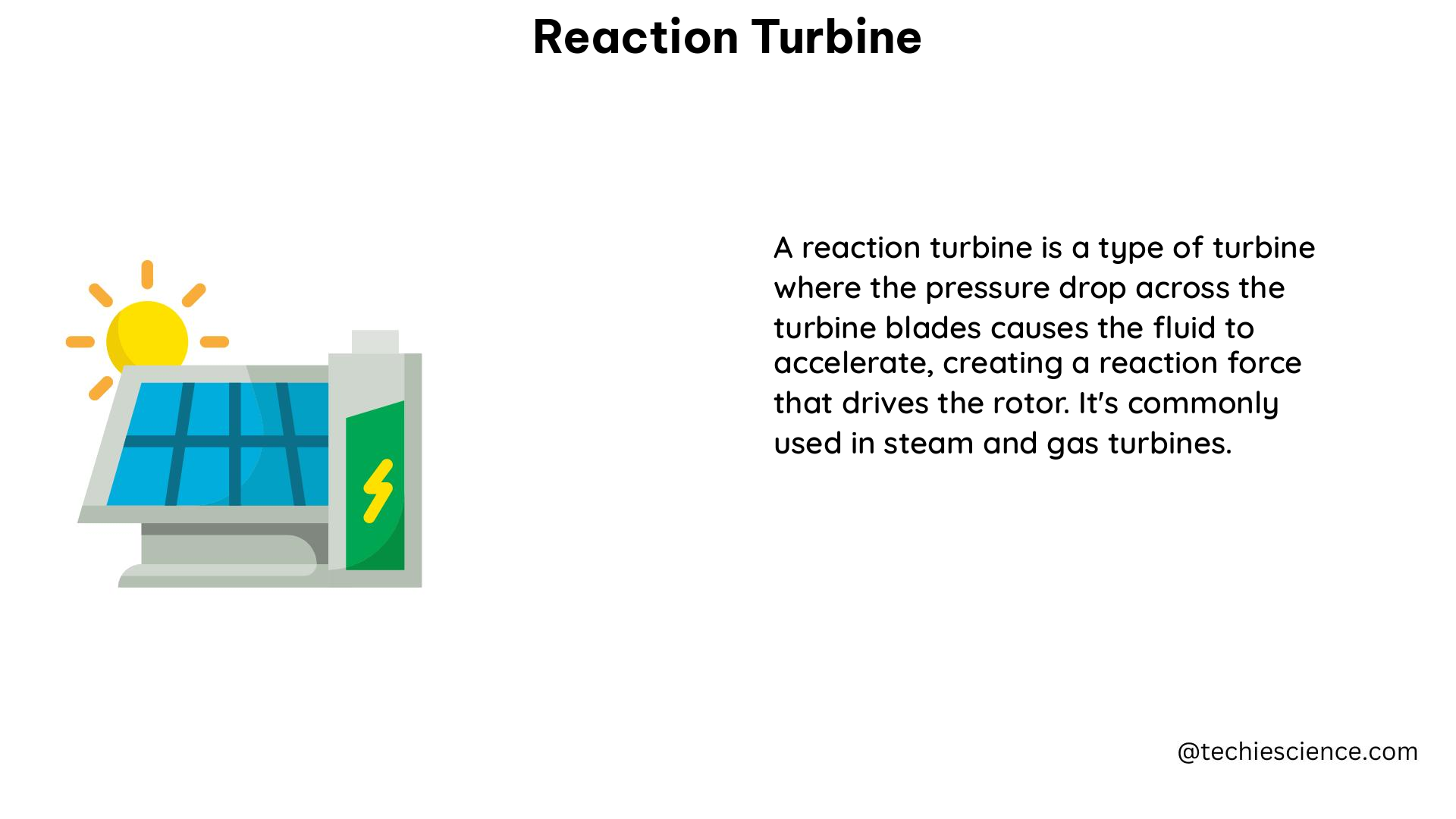Reaction turbines are a type of hydraulic turbine that convert the kinetic energy of a fluid, such as water, into mechanical energy. These turbines are designed to harness the reaction force generated by the accelerating fluid flow within the turbine runner, making them highly efficient and versatile in a wide range of applications, from hydroelectric power generation to industrial processes.
Understanding the Principles of Reaction Turbines
Reaction turbines operate on the principle of the conservation of momentum. As the fluid flows through the turbine, its velocity increases, and the resulting change in momentum creates a reaction force that drives the rotation of the turbine runner. This reaction force is the primary source of the mechanical power generated by the turbine.
The performance of a reaction turbine can be analyzed through various studies and tests, such as the one conducted on a model Francis turbine. This study revealed that the peak efficiency of the turbine was between 76-88% of full load, with a maximum efficiency of 74% achieved at a 95% wicket gate opening. Characteristic curves were plotted in terms of unit quantities, showing the trends in discharge, power, and efficiency with respect to unit speed. These results were then used to predict the performance of a larger prototype turbine.
Blade Design and Optimization

The design and testing of high-reaction turbine blade profiles is a critical aspect of improving the overall efficiency of these machines. Researchers have conducted numerical simulations and experimental studies to evaluate the performance of new blade profiles with variable inlet angles and Mach numbers.
One such study showed that the performance of a newly designed blade profile was better than the original profile, with an increase in efficiency of about 0.5%. This improvement was achieved through careful optimization of the blade geometry, including the leading and trailing edge shapes, as well as the blade curvature and thickness distribution.
Factors Affecting Reaction Turbine Performance
The performance of a reaction turbine is influenced by a variety of factors, including:
-
Fluid Flow Characteristics: The velocity, pressure, and flow rate of the fluid entering the turbine have a significant impact on the reaction force and, consequently, the power output.
-
Turbine Geometry: The design of the turbine runner, including the blade shape, number of blades, and overall dimensions, can significantly affect the efficiency and power output of the turbine.
-
Operating Conditions: Parameters such as the head (difference in water elevation), rotational speed, and load on the turbine can all influence its performance.
-
Cavitation: The formation of vapor bubbles in the fluid can lead to erosion and reduced efficiency, and must be carefully managed through proper design and operation.
-
Mechanical Losses: Friction, windage, and other mechanical losses within the turbine can reduce the overall efficiency and must be minimized through careful engineering.
Optimizing Reaction Turbine Performance
To optimize the performance of a reaction turbine, engineers and researchers employ a variety of techniques, including:
-
Computational Fluid Dynamics (CFD) Modeling: CFD simulations can be used to model the fluid flow within the turbine and optimize the blade and runner design for maximum efficiency.
-
Experimental Testing: Physical testing of turbine models and prototypes is essential for validating the CFD results and fine-tuning the design.
-
Advanced Manufacturing Techniques: Innovative manufacturing methods, such as additive manufacturing, can be used to produce complex, high-performance turbine components with improved precision and reduced lead times.
-
Condition Monitoring and Predictive Maintenance: Continuous monitoring of the turbine’s operating parameters and condition can help identify potential issues early and optimize maintenance schedules, improving overall reliability and efficiency.
-
Integrated System Design: Considering the turbine as part of a larger hydroelectric or industrial system can lead to further optimization opportunities, such as matching the turbine characteristics to the specific application requirements.
Conclusion
Reaction turbines are a crucial component of many industrial and energy-generating systems, and their performance is a critical factor in the overall efficiency and reliability of these systems. By understanding the principles of reaction turbine operation, optimizing the blade design, and employing advanced techniques for performance enhancement, engineers and researchers can continue to push the boundaries of what is possible in hydraulic power generation and industrial applications.
References:
- Britannica. (n.d.). Reaction turbine. Retrieved from https://www.britannica.com/technology/reaction-turbine
- Slideshare. (n.d.). Hydraulic Turbines. Retrieved from https://www.slideshare.net/slideshow/f56053135-51186604/51186604
- Pt.csust.edu.cn. (n.d.). Performance Prediction of a Francis Turbine Based on Model Test. Retrieved from http://pt.csust.edu.cn/meol/analytics/resPdfShow.do%3Bjsessionid=91DB213DEED6E459A70FCD22DB202203?lid=11245&resId=851668
- IOP Science. (2022). Design and test study of a high reaction turbine blade profile. Retrieved from https://iopscience.iop.org/article/10.1088/1742-6596/2707/1/012151

The lambdageeks.com Core SME Team is a group of experienced subject matter experts from diverse scientific and technical fields including Physics, Chemistry, Technology,Electronics & Electrical Engineering, Automotive, Mechanical Engineering. Our team collaborates to create high-quality, well-researched articles on a wide range of science and technology topics for the lambdageeks.com website.
All Our Senior SME are having more than 7 Years of experience in the respective fields . They are either Working Industry Professionals or assocaited With different Universities. Refer Our Authors Page to get to know About our Core SMEs.